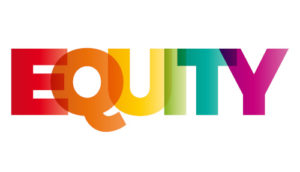Financial mismanagement and the student debt crisis are dominating headlines. The pandemic brought most classrooms off campus and into student, educator, and family homes. Fernanda Borges Nogueira, Senior Network Program Manager at the Roosevelt Institute, noted, “What this whole crisis has done to higher education is just exposed the cracks that have been there for over a decade of financial mismanagement.”
Yes, there is a financial crisis in higher education, but what if these issues were examined through an equity lens? We’ve witnessed declining enrollments, rising tuition and student loan interest costs outpacing inflation, little to no return on investment for graduates in today’s job market, financial mismanagement, admission scandals, and antiquated curriculum that does not prepare students for practical life. We argue that the stem of the financial crisis is really an equity crisis.
From a student perspective, it is time for an education that meets today’s world. Attempting to create equity in systems that weren’t designed with equity in mind only reinforces hierarchy in governance systems. Thus, positions of power continue to be reserved for wealthy, educated, white individuals who historically have controlled our country’s landscapes (pun intended).
Equity in the form of diversity and inclusion practices has become a well-established trend in academia in an attempt to meet pressure from social justice movements that feature student protests and a call for change. Implementing a DEI program to drive recruitment initiatives neither addresses the systems built without equity in mind nor produces profound changes to campus cultures. It’s a bandage over a gaping wound–a treatment of a system, not the illness.
Students deserve a learning environment where they feel safe, supported, and learn from a population that reflects themselves, their communities, and the diverse global population. Universities will never truly engage and retain the breadth of diversity they wish to attract if those same populations are not included at the table when institutional overhaul is being designed.
All of this is predicated on the privilege to attend university. We must also acknowledge that there are mainstay barriers to access to higher education. If addressed, those barriers are evaluated from a student experience, as they should be. It’s important to consider that financial barriers also affect our employed campus communities.
Moving expenses, gaps in new-hire insurance coverage, and single end-of-month pay systems preclude many graduate students, junior faculty members, and adjuncts from taking jobs and finding housing, thereby limiting their options on their path to success. Being able to move, having enough in savings to wait for that first paycheck, and not needing a month of health coverage is a financially privileged and ableist perspective. Schools need to better address prospective employees’ financial burdens in relocating and/or transitioning to a new institution.
Once employed, retirement plans reinforce a wealth gap that is naturally most prominent at well-funded institutions. Many have called out the anti-humanitarian and antiquated pay structures designed to mirror hierarchies of power, lining the pockets of upper administration; others have had no choice but to live in cars and tents. (Aimée Lê’s story featured in The Guardian is the most recent of published examples.) This classist, racist, sexist, homophobic, transphobic, and ablest structure is reinforced by not contributing to adjunct and graduate student retirement plans and paying qualifying employees based on their current salary, widening the class divide.
The solution is quite simple: equal pay for equal work and equal retirement contributions among all campus employees. We recognize many institutions will sweep past this idea, hiding behind budget constraints and institutional bylaws. We encourage all higher education employees to hold your institutions accountable, and even more so that those in positions of power commit to doing the work we know can be done.
We implore universities to stop blaming their financial woes for their limitations to change when what we’re experiencing is a failure to address inequity in campus populations. That is not to say universities don’t face financial problems; we know categorically they do. It is to say that some of that burden would be remedied by addressing the root of the problem (inequity and misappropriation of funds) rather than the symptom.
Intuitions need to embody and model equity. These issues aren’t being solved by mere acknowledgment of their existence and empty action plans to investigate their impact. Campus communities have been telling you their impact, pleading for change. It’s time to triage inequity; it’s time for action.
- A bungled FAFSA rollout threatens students’ college ambitions - April 19, 2024
- Using real-world tools to prepare students for the workforce - April 18, 2024
- 8 top trends in higher education to watch in 2024 - April 16, 2024

